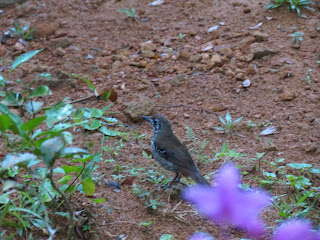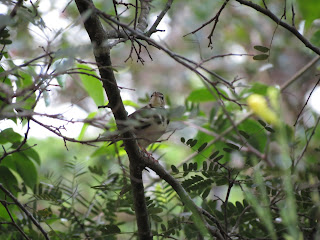SQUIRRELS
We saw two different species of squirrel.
INDIAN PALM SQUIRREL
The Indian palm squirrel Funambulus palmarum is by far the commonest of these. It is abundant almost throughout Sri Lanka and many of them inhabit my aunt's garden. Their chirruping alarm calls can easily be mistaken for those of a bird, a mistake I have made many many times. They are also very cute-looking. In Sinhala this is known as laena.
GRIZZLED GIANT SQUIRREL (dry zone)
GRIZZLED GIANT SQUIRREL (subspecies dandolena)
I saw three different subspecies of the Grizzled giant squirrel Ratufa macroura on my trip. Classified as Near Threatened, this large species of squirrel is best seen in Sri Lanka. I saw the wet zone subspecies dandolena in Sinharaja, the hill country subspecies in Horton Plains and the dry zone subspecies at Ulagalla. The wet zone subspecies can also be found in India. In Sinhala this squirrel is known as dandolena. It is the smallest of the giant squirrels of the Indian Subcontinent.BATS
I saw an unidentified species of microbat flying around Martin's Lodge in Sinharaja, but could not get a photo. I also saw a few dead common flying foxes, but they do not really count.
MONKEYS
I saw all three species of monkey that inhabit Sri Lanka. In Sinhala all are known as 'vandhura'.
TOQUE MACAQUE
The toque macaque Macaca sinica is a reddish-brown coloured monkey with a pink face, and is endemic to Sri Lanka. It is known in Sinhala as the rilewa and has a whorl of hair on its head. It is also known as the temple monkey, because of its abundance in the Sri Lankan Cultural Triangle. Despite this it is recognised as Endangered. There were many at Ulagalla and I spotted some drinking from our jacuzzi. There were also some along the road to Bandarawela.
TUFTED GREY LANGUAR (subspecies thersites)
The tufted grey langur Semnopithecus priam is much shyer than the macaque but can also be found in the Cultural Triangle, though it is not as common as the macaque (however, one sometimes visits my aunt's garden in Colombo). It is pale grey with a long tail and black face. There are two subspecies. The nominate is found only in India and subspecies thersites in the Western Ghats of India and Sri Lanka. It eats leaves.
PURPLE-FACED LEAF MONKEY (subspecies vetulus)
Finally, the purple-faced leaf monkey is a species of monkey endemic to Sri Lanka. It is also known as the purple-faced langur and is a long-tailed, tree-dwelling species. Once very common, this monkey is now much rarer, though it is still fairly common to abundant in the right places. It is considered Endangered. There are four distinct subspecies. The western subspecies, nestor, was once common throughout Colombo but now is one of the 25 most endangered primates in the world, and can only reliably be seen at Thalangama Tank (see posts about the tank for a photo). The hill country subspecies (bear monkey), monticola, has thicker fur than the other subspecies and can be seen at the Hakgala Botanic Gardens near Nuwera Eliya. The southern wetzone subspecies vetulus (shown here) is the commoner subspecies of the wet zone and can be seen at Sinharaja. Finally the dry zone subspecies philbricki I have not yet seen so cannot provide advice about seeing.MONGOOSES
There are four species of mongoose in Sri Lanka, the stripe-headed, ruddy, grey and Indian brown mongooses. I spotted one species on my trip.
INDIAN BROWN MONGOOSE
The Indian brown mongoose Herpestes fuscus is a quick, shy creature that is the commonest of Sri Lanka's mongooses. It is very similar to the Southeast Asian short-tailed mongoose and is often considered to be a subspecies of that. It can be found in southwestern India and Sri Lanka, and is classified as Vulnerable. I spotted one at Horton Plains. Apparently Thalangama Tank's surrounds can be a good spot for this species but I have never seen one there.DEER
There are three native species of deer in Sri Lanka, and one that may be introduced. I saw one of these.
SAMBAR DEER (subspecies unicolor)
The sambar deer is the largest of Sri Lanka's deer species. The nominate subspecies unicolor is found in Sri Lanka. It is a large deer native to the Indian subcontinent, and Southeastern Asia. It has also been introduced to New Zealand, Australia and St. Vincent Island in Florida. At Horton Plains you are almost guaranteed to see at least one of these deer.Those are the mammals I saw.


















































